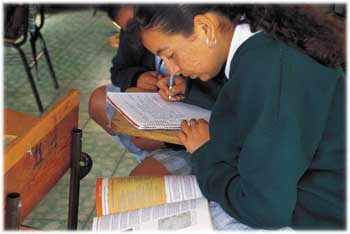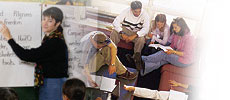|
|
|
Education as Top Priority: The Challenges of Education Reform
Kah Ying Choo
For many decades, education with its seemingly insurmountable challenges has captured the public spotlight. Ideally, education serves a critical role for society by cultivating future |  |  | | generations who will be able to express their individuality and creativity, thus improving society as a whole (Blitz, 2001, p. 24). However, this goal is often buried underneath the nation’s obsessive pursuit to raise test scores as an indicator of improvement of the education system. What have truly alarmed policymakers and the public are the low scores of students, especially disadvantaged ones. National reading tests indicate that almost 70 percent of inner city fourth graders do not have a basic level of reading proficiency. In international math tests, high school students in Cyprus and South Africa surpass American high school seniors in their results (“No Child Left Behind Executive Summary,” 2001, p. 1). On the most superficial level, the failure of the school system to improve test scores has thrust it to the forefront of the federal government’s and the public’s agenda. Upon his succession as the new President, President George W. Bush created the No Child Left Behind proposal in a bid to accomplish the incredible feat of passing a landmark education reform bill (“No Child Left Behind Executive Summary,” 2001, p. 1). The recent passage of the education reform bill is a result of the federal government’s persist promotion of the bill and the endless negotiations with the key politicians of Congress behind closed doors (Robelen, 2001, p. 1). The federal government’s focus on the education reform bill is further evidenced by the difficult journey of No Child Left Behind Act from the White House to its current status. Contentious discussions between Democrats and Republicans over the controversial provisions of this bill such as vouchers, the type of annual tests and the overall funding for these programs constantly jeopardized the bill. Even in the midst of the economic slowdown and the war against terrorism, the federal government finally succeeded in pushing through the passage of the education reform bill (Samuelson, 2001; Anderson, 2001a & 2001b; Brownstein, 2001; Garvey, 2001a & 2001b). Clearly, education is one of the top priorities of the federal government. The substantial government spending on education over the years also reflects the high prioritization of education. According to the U.S. Census Bureau (2000), the total government spending on education at federal, state and local levels was $311.7 billion in 1997, an increase of six percent ($18.9 billion) from 1996. Total expenditure per public pupil has also climbed steadily from $5,000 in 1983 to $6,943 in 1998 (“1998 Digest of Education Statistics,” cited in Public Agenda Online, 2002c). Even more recently, Christie (2001) reports the increase of per-student expenditures by 30.6 percent between 1996 and 2001. | |  |  | At the same time, education is also considered the top priority for the American public. In a poll conducted by Princeton Survey Research Associates, 76 percent of the respondents asserted that the federal government should increase spending for education, thus ranking education as the most important issue among 14 issues including health care, Medicare and crime (cited in Public Agenda Online, 2002b).
Today, the trends of globalization and technological changes that have transformed the workplace has given education reform a strong impetus in order to create an education system that will work in a new world. For close to a century, people were accustomed to obtaining a well-paid professional job once they completed their high school and college education. However, | with the restructuring of the economy, even professionals such as lawyers, engineers and doctors struggle to acquire and hold onto their jobs. These realities send a clear signal that the traditional school system of education needs to be changed in order to move in synch with the times (Aronowitz, 1996, p. 144).
Although the environment for change has been ripe for several years, American policymakers, educators and the general public are divided in their perceptions of the problems plaguing the education system. Currently, there are four conflicting perspectives regarding the deficiencies of the education system and proposed solutions:
• Improve existing public school system by increasing national standards: The proponents of this approach believe that schools have failed to provide a basic level of academic education to students. Therefore, the establishment of core courses and higher academic standards will improve the education system (Public Agenda Online, 2002a). The education reform bill with its emphasis on testing and accountability falls into this group.
• Improve the existing school system by providing adequate funding: Because many schools are forced to operate on a small budget, they are unable to provide quality education for students. However, this approach is undermined by the simple reality that even with the massive investment of federal education programs amounting to $120 billion a year, the academic performance of elementary and high school students remains abysmal (“No Child Left Behind Executive Summary,” 2001, p. 1).
• Challenging the existing school system by offering educational choices: The proponents of this approach believe that the problem with the school system is the lack of affordable educational choices available to parents. Because public schools monopolize the education industry, they do not need to compete with other schools. Consequently, they do not have the incentive to improve their performance (Public Agenda Online, 2002a). These individuals thus support the use of vouchers and the establishment of charter schools (Blitz, 2001).
While the education debate among policymakers and the public in this country has largely revolved around the first three perspectives, the perspective that comes closest to addressing the ultimate objective of education is:
• Reform the public school system completely by creating student-centered schools: The proponents of this approach argue that the teacher-centered traditional school system that imposes a standardized curriculum on students is the fundamental problem. This perspective strikes at the heart of the current public schooling system. However, authentic learning can only occur when students are encouraged to take an active role in the learning process. They learn how to solve problems and collaborate with one another in various settings. Beyond acquiring knowledge, the students are cultivating a capacity to think that will enable them to handle real-life situations. As generalists, these students will grow up to become adults who are able to rapidly adapt to a variety of situations in the challenging new world, earn a decent income and become happy and productive citizens of the future (Gordon, 1998, p. 390).
Anderson, N. (2001a, May 4). Revised education bill is unveiled. The Los Angeles Times, p. A21.
Anderson, N. (2001b, May 23). House endorses plan to expand school testing. The Los Angeles Times, p. A1.
Aronowitz, S. (1996, January-February). National standards would not change our cultural capital. The Clearing House, 69(3), 144-147.
Blitz, M. (2001, January). Setting domestic priorities—We need a federal government that encourages individual freedom and responsibility. World and I, 16(1), 24-28.
Brownstein, R. (2001, March 7). Allies are forcing Bush to bend on school testing reform: He’s yielding on how states measure student performance, as some in GOP push ‘local control’ issue. The Los Angeles Times, p. A1.
Christie, K. (2001, December). Stateline—States wrap up the year. Phi Delta Kappan, 83(4), 281-283.
Gordon, R. (1998, January). Balancing real-world problems with real-world results. Phi Delta Kappan, 79(5), 390-393.
No Child Left Behind Executive Summary. (2001, January 29). Retrieved February 5, 2002, from U.S. Department of Education Website: www.ed.gov/inits/nclb/part2.html
Garvey, M. (2001a, June 13). Senate won’t buy even a diluted version of voucher remedy education: Modest pilot program, what’s left of Bush plan, is defeated. The Los Angeles Times, p. A16.
Garvey, M. (2001b, June 16). Trouble may lurk in details of education bill: Questions loom about funding, testing. Critics say potential effects are being oversold. The Los Angeles Times, p. A12.
Public Agenda Online (2002a). The perspectives in brief. Retrieved February 5, 2002, from http://www.publicagenda.org/issues/debate_brief.CFM?issue_type=education
Public Agenda Online (2002b). Princeton Survey Research Associates. Retrieved February 5, 2002, from http://www.publicagenda.org/major_proposals_detail2.cfm?issue_type=education&proposal_graphic
=mpbudget.gi
Public Agenda Online (2002c). Spending per pupil. Retrieved February 5, 2002, from http://www.publicagenda.org/issues/factfiles_detail.cfm?issue_type=education&list=16
Robelen, E. W. (2001, December 13). House overwhelmingly passes sweeping education reform bill. --Education Week, 21(15). Retrieved February 7, 2002, from http://www.edweek.org/ew/ew_printstory.cfm?slug=15esea_web2.h21
Samuelson, R.J. (2001, January 31). It’s about goals, not vouchers. The Washington Post, p. A21.
U.S. Census Bureau. (2000, August 28). Education facts from the U.S. Census Bureau. Retrieved February 5, 2002, from www.nsba.org/pressroom/edfacts.htm PRINTABLE PAGE | BACK | TOP | NEXT | PRINTABLE SITE | | |
